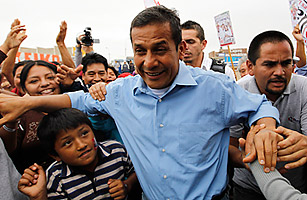
Peru is a mining country. Mining accounts for far more than half of the country’s exports; taxes paid by mining companies equal more than 10% of the government’s annual budget. Peru is the world’s top silver producer, second in copper and in the top six of a long list of other metals, including gold. So, when someone tinkers with mining — or even talks about tinkering with it — the country’s economic drivers go haywire.
President-elect Ollanta Humala, who squeaked to a narrow victory in Sunday’s voting against Congresswoman Keiko Fujimori — he had 51.3% of the vote with 90% of the ballots counted — found out quickly just how touchy mining investors can be.
Humala’s original campaign platform talked about mining and other natural resources as strategic sectors that needed to be in the service of the state. The plan included a windfall tax on mining and allowing local communities to reject mining or oil and gas concessions through referendums. As it became clear that Humala was about to become Peru’s next president, those three planks spooked investors.
Peru’s stock market, which is top-heavy with mining companies, plunged as soon as it opened Monday morning. It nosedived nearly 9% in a matter of minutes and trading was halted. It then reopened but closed early when the selloff went viral. The General Index fell 12.5%, the worst one-day drop in the bourse’s history. Meanwhile, the local currency, which had gained more than 2% on the U.S. dollar in May, its largest in 18 months, lost 1.2%.
Adding to the hysteria was the fear that Humala might be an acolyte of Venezuelan President Hugo Chvez. As a result, confidence dissipated in the country’s growing economy — at nearly 9%, one of the fastest in the world. At risk, it seemed, would be tens of billions of dollars in mining and oil and gas projects on the drawing board.
Lost in the sell-off was Humala’s apparently successful attempt to sell himself to the electorate as a much more moderate candidate than his reputation presupposed. Indeed, the former military man is not the same candidate who presented the lengthy, left-wing campaign platform last December. He is not even the same candidate who won the right to compete in Sunday’s run-off by coming in with the most votes in a first round of voting in April. “He has been evolving and modifying his views,” says Manuel Torrado, of the DATUM polling firm.
Indeed, by April, the Humala campaign had presented a watered down version of its platform; and in May he unveiled a “road map” that he said would be the basic architecture of his government that made no mention of “strategic sectors” or the state’s need to have a guiding role in the economy. He also took a pledge on the Bible not to deviate from the general political and economic framework that has apparently led to Peru’s dramatic growth. Humala’s revisions received the strong support of former President Alejandro Toledo and Mario Vargas Llosa, who won the Nobel Prize for Literature last year. Both, in all likelihood, contributed to the little bump Humala needed to win.